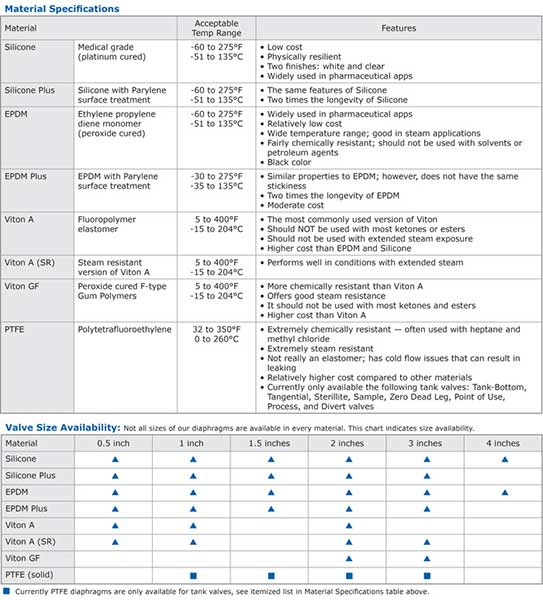ASEPCO’s Parylene-Treated Diaphragms: Silicone Plus and EPDM Plus
Try our outstanding Parylene-surfaced Silicone and EPDM diaphragms
ASEPCO offers two material choices for diaphragms that have a surface treatment called Parylene (Type N): Silicone Plus and EPDM Plus. Parylene is a material that mechanically bonds itself to the base elastomer. Parylene is not put on as a simple coating; the powder is vaporized and applied in a vacuum by vapor deposition. The result is a conforming surface that is very thin (~0.002 inch), uniform, and impermeable. It does not peel or flake off with wear. Even better, it does not compromise the elastomeric qualities of the underlying material.
Parylene is a high molecular-weight, linear, crystalline polymer that has an all-carbon backbone without any oxygen, nitrogen, or sulfur atom links in the backbone, so it is hydrophobic. This carbon backbone, coupled with its substantial crystallinity, makes Parylene quite stable and highly resistant to chemical attack. As a result, Parylene’s chemical resistance is similar to Teflon. It resists attack and is insoluble in all organic solvents up to 150°C and is resistant to permeation by most solvents with the exception of aromatic hydrocarbons.
Probably the best feature of Parylene is that it eliminates the stickiness often encountered with EPDM.
The slickness of the Parylene treatment greatly reduces the sticking that occurs when the valve is actuated. In addition, operators can easily remove EPDM-treated diaphragms from the valve during maintenance.We find that the Parylene treatment greatly enhances the performance of the base elastomer. In our experience, the Parylene treatment typically doubles the life of Silicone and EPDM diaphragms (especially in steam applications), and it costs significantly less than twice the price, resulting a significant reduction in maintenance costs.
Parylene is not new, it has been used for over 30 years to cover medical devices, such as pacemakers and shunts. It is USP Class IV certified. ASEPCO is currently, however, the only company that is using it as a treatment to enhance the performance of their diaphragms.
Although not quite as chemically resistant as Teflon, Parylene has a distinct advantage over Teflon for use in diaphragms. Because it is only a thin surface on an elastomer, it flexes with the underlying rubber. The result is that you get true sealing with the valve body and there is no cold flow, and therefore no leaking.
Features & Benefits

USP Class VI certified (like all our other diaphragm materials)
Continuous pinhole-free in thickness down to 500 angstroms
Insoluble in organic solvents @ <150°C
Unaffected by most acids and alkalis
Low moisture permeability
Dry film lubricity approaching that of PTFE
Thermal mechanically stable between -40°C and 150°C
Flexes with the rubber—no cold flow
Because it is only a surface on an elastomer, you get true sealing
Increases diaphragm life (doubles the life of our standard silicone and EPDM during in house steam testing)
Increases chemical resistance—Parylene is inert
Proven biological safety—Parylene is a well-known coating for pacemakers
Specifications
ASEPCO provides diaphragms created with a number of different materials. The materials vary with respect to heat-resistance, chemical-resistance, and durability. The table below shows basic compatibility information. Please do not use this information as your sole method for determining whether an elastomer is right for your specific process. Before using any elastomer in a process you should verify its compatibility with an elastomer expert.


